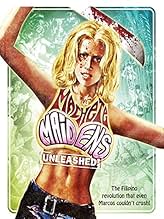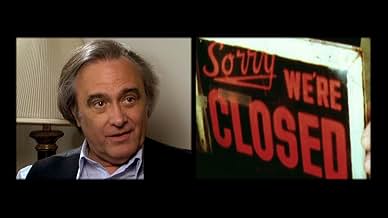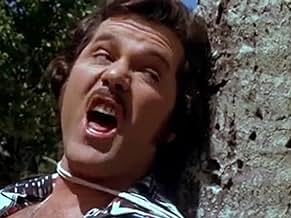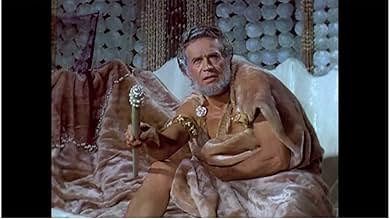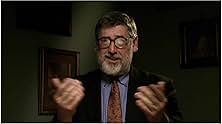AVALIAÇÃO DA IMDb
7,3/10
1,9 mil
SUA AVALIAÇÃO
Adicionar um enredo no seu idiomaA fast moving odyssey into the subterranean world of the rarely explored province of Filipino genre filmmaking.A fast moving odyssey into the subterranean world of the rarely explored province of Filipino genre filmmaking.A fast moving odyssey into the subterranean world of the rarely explored province of Filipino genre filmmaking.
Gerardo de Leon
- Self - Director
- (cenas de arquivo)
- Direção
- Roteiristas
- Elenco e equipe completos
- Produção, bilheteria e muito mais no IMDbPro
Avaliações em destaque
A fast moving odyssey into the subterranean world of the rarely explored province of Filipino genre filmmaking.
I love horror films and exploitation films and consider myself both a critic and historian (having now reviewed over 2000 films and written numerous articles). Yet, I must confess, I was not aware of the hundreds -- perhaps thousands -- of films that were made in the Philippines. I knew about some of them, of course, but did not know just how huge the output was.
Wow! This is one of the best documentaries I have ever seen on exploitation films (and I have seen my share). John Landis never disappoints, and some unusual suspects show up, too. R. Lee Ermey? Who knew?
I love horror films and exploitation films and consider myself both a critic and historian (having now reviewed over 2000 films and written numerous articles). Yet, I must confess, I was not aware of the hundreds -- perhaps thousands -- of films that were made in the Philippines. I knew about some of them, of course, but did not know just how huge the output was.
Wow! This is one of the best documentaries I have ever seen on exploitation films (and I have seen my share). John Landis never disappoints, and some unusual suspects show up, too. R. Lee Ermey? Who knew?
This documentary with it's (deliberately?) misleading title, gives viewers a brief overview of the Filipino cult cinema of the sixties, seventies and eighties. In a seemingly endless string of fragmented interviews (some of the edits so short that the subject's title is flashed for a fleeting moment), the film tries to draw an overview of this period of American/Filipino co-productions. Archival footage is interspersed here and there, and occasionally we are given context.
Is it interesting? Yes, but as much as it is frustrating. For you will certainly find that the film never settles down from its opening moments. The pace of the film is that of one tempo, as if the editor was worried that we might lose interest, or as if the visual information was paramount and the factual information (something I'm more interested in than anecdotal) was a mere triviality. You will be bombarded with cuts and clips and cues for the duration of the film - it's an editing style borne from the free-to-air TV realm that transposes to the cinema with a terrible effect.
Also, the relentless funk soundtrack (the staple to the C-Grade Grindhouse films) undermined the interviewees' comments, robbing them of any memorable moment and washing them altogether with the same colour. I can't help but relate the style of this documentary with American style 20-to-1 type shows, where the interviewees are there to provide colour to a proposed topic, not to provide any real insight. This is the films worst crime, for Filipino film-makers we are shown are outnumbered five-to-one by the Americans, yet the tiny grabs we are given with these eccentric characters were far more interesting and exotic.
This film belongs on a commercial or pay TV network, but the limited audience and scope of the film will probably condemn it to the Australian Broadcasting Corporation's schedule sometime in the near future. Wait for it then, for the cinema gives little to this difficult documentary.
Is it interesting? Yes, but as much as it is frustrating. For you will certainly find that the film never settles down from its opening moments. The pace of the film is that of one tempo, as if the editor was worried that we might lose interest, or as if the visual information was paramount and the factual information (something I'm more interested in than anecdotal) was a mere triviality. You will be bombarded with cuts and clips and cues for the duration of the film - it's an editing style borne from the free-to-air TV realm that transposes to the cinema with a terrible effect.
Also, the relentless funk soundtrack (the staple to the C-Grade Grindhouse films) undermined the interviewees' comments, robbing them of any memorable moment and washing them altogether with the same colour. I can't help but relate the style of this documentary with American style 20-to-1 type shows, where the interviewees are there to provide colour to a proposed topic, not to provide any real insight. This is the films worst crime, for Filipino film-makers we are shown are outnumbered five-to-one by the Americans, yet the tiny grabs we are given with these eccentric characters were far more interesting and exotic.
This film belongs on a commercial or pay TV network, but the limited audience and scope of the film will probably condemn it to the Australian Broadcasting Corporation's schedule sometime in the near future. Wait for it then, for the cinema gives little to this difficult documentary.
I watched a couple of women-in-prison movies the other day. Both were made in the Philippines. This documentary goes behind the scenes to show why and how Roger Corman type films were made there. Cheap actors and lax safety rules made for an ideal situation for making low budget films.
Blood, breasts, and beasts were the staples of films like Mad Doctor of Blood Island, Beast of Blood, The Big Doll House, Women in Cages, Black mama, White Mama,The Big Bird Cage, and the classic Vampire Hookers.
We see stars like Pam Grier learning the craft in these cheap films. Part of a new wave of women as action heroes, which was new to moviegoers.
The documentary was invaluable in understanding the background of filmmaking.
Blood, breasts, and beasts were the staples of films like Mad Doctor of Blood Island, Beast of Blood, The Big Doll House, Women in Cages, Black mama, White Mama,The Big Bird Cage, and the classic Vampire Hookers.
We see stars like Pam Grier learning the craft in these cheap films. Part of a new wave of women as action heroes, which was new to moviegoers.
The documentary was invaluable in understanding the background of filmmaking.
This was a an absolutely brilliant documentary on the history of film making back in the 70s and 80s in the Philippines.
Why the Philippines? Because it was cheap....very cheap and pretty much no rules with what you could do.
Most of the movies made then were b grade or grindhouse made for the drive ins. Though one big budget classic was made there ..... Apocalypse Now.
This documentary was made by the same people who made Not Quite Hollywood and Electric Boogaloo -The Wild, Untold Story Of Canno Films...both of witch are brilliant documentaries as well.
Great insights from Roger Corman, Pam Grier, John Landis, Joe Dante, R. Lee Emery Sid Haig, Chris Mitchum etc.
If you love 70s, 80s B movies this documentary is a must see!!!
Why the Philippines? Because it was cheap....very cheap and pretty much no rules with what you could do.
Most of the movies made then were b grade or grindhouse made for the drive ins. Though one big budget classic was made there ..... Apocalypse Now.
This documentary was made by the same people who made Not Quite Hollywood and Electric Boogaloo -The Wild, Untold Story Of Canno Films...both of witch are brilliant documentaries as well.
Great insights from Roger Corman, Pam Grier, John Landis, Joe Dante, R. Lee Emery Sid Haig, Chris Mitchum etc.
If you love 70s, 80s B movies this documentary is a must see!!!
Starting from the the 1950's war pictures and ending in 1980, this documentary covers films made in the Philippines but made for American audiences or exported to America. Bomba films are not covered as they were not exported.
Interviewed are actors, actresses, directors, producers directly involved in these films or occasionally their relatives. Director John Landis curiously appears several times but I'm not aware of any involvement he had with Filipino filmmaking.
They go thru a host of low budget films, that used the Philippines location as they explain in detail was cheap. It is those particular details plus explaining the evolving political situation that steps this documentary up a few notches. Besides the films, some directors including Cirio Santiago, Bobby Suarez & others even explaining their styles & approach to the films. This is important as they influenced American filmmakers, notably Quentin Tarantino who were fans. Even Apocalypse Now was talked about.
They really stuffed a lot of related subjects and insights into this documentary. I also liked how they sometimes edited parts of interviews together as if the next person was responding to the previous one. It does help if you know or interested in filmmaking itself as that's the main focus. As a huge film buff, I was fascinated from beginning to end.
Interviewed are actors, actresses, directors, producers directly involved in these films or occasionally their relatives. Director John Landis curiously appears several times but I'm not aware of any involvement he had with Filipino filmmaking.
They go thru a host of low budget films, that used the Philippines location as they explain in detail was cheap. It is those particular details plus explaining the evolving political situation that steps this documentary up a few notches. Besides the films, some directors including Cirio Santiago, Bobby Suarez & others even explaining their styles & approach to the films. This is important as they influenced American filmmakers, notably Quentin Tarantino who were fans. Even Apocalypse Now was talked about.
They really stuffed a lot of related subjects and insights into this documentary. I also liked how they sometimes edited parts of interviews together as if the next person was responding to the previous one. It does help if you know or interested in filmmaking itself as that's the main focus. As a huge film buff, I was fascinated from beginning to end.
Você sabia?
- CuriosidadesAll the footage of Quentin Tarantino interviewing Cirio H. Santiago had to be cut from the final finished version of the film.
- ConexõesFeatured in Kain's Quest: The Arena (2017)
- Trilhas sonorasLet's Go Where the Action Is
Written and Performed by Tommy Boyce and Bobby Hart
Principais escolhas
Faça login para avaliar e ver a lista de recomendações personalizadas
- How long is Machete Maidens Unleashed!?Fornecido pela Alexa
Detalhes
- Data de lançamento
- País de origem
- Centrais de atendimento oficiais
- Idioma
- Também conhecido como
- Machete Maidens Unleashed!
- Locações de filme
- Empresas de produção
- Consulte mais créditos da empresa na IMDbPro
- Tempo de duração
- 1 h 24 min(84 min)
- Cor
- Proporção
- 1.78 : 1
Contribua para esta página
Sugerir uma alteração ou adicionar conteúdo ausente


